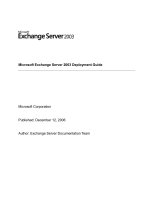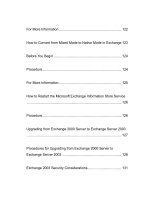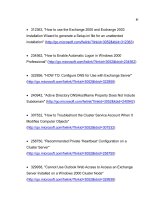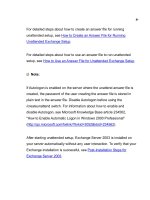Microsoft Exchange Server 2003 Deployment Guide- P32 pps
Bạn đang xem bản rút gọn của tài liệu. Xem và tải ngay bản đầy đủ của tài liệu tại đây (233.59 KB, 10 trang )
311
4. On the Completing the Active Directory Connector Installation
Wizard page, click Finish.
312
Deploying Exchange Server 2003 in a Cluster
After planning the cluster deployment strategy, correct deployment of that
cluster ensures high availability of your servers that run Microsoft®
Exchange Server 2003. Although deploying Exchange in a cluster
resembles deploying Exchange in a non-clustered organization, there are
important differences you must consider. Therefore, to fully understand
how to deploy Exchange Server 2003 in a cluster, read this topic together
with the previous topics in this guide.
Specifically, this topic provides the following information:
Cluster Requirements
This section discusses the necessary requirements for installing
Exchange Server 2003, including Microsoft Windows® and Exchange
version requirements, software requirements, and network configuration
requirements.
Deployment Scenarios
This section includes the following configuration and procedural
information about how to deploy Exchange Server 2003 clusters:
313
Four-node cluster scenario
Deploying a new Exchange Server 2003 cluster
Upgrading an Exchange 2000 Server cluster to Exchange
Server 2003
Migrating an Exchange Server 5.5 cluster to Exchange Server 2003
Upgrading mixed Exchange 2000 Server and Exchange Server 5.5
clusters
Before continuing with the deployment procedures listed in this topic,
follow these steps:
Read the section "Using Server Clusters" in the guide Planning an
Exchange Server 2003 Messaging System
(
Create a Windows 2000 Server or Microsoft Windows Server™ 2003
cluster. To create a Windows 2000 or Windows Server 2003 cluster, see
the following resources:
314
Windows Server 2003 For information about how to create a
Windows Server 2003 cluster, see Checklist: Preparation for installing a
cluster (
Windows 2000 For information about how to create a
Windows 2000 cluster, see Step-by-Step Guide to Installing Cluster
Service (
Cluster Requirements
Before you deploy Exchange Server 2003 on a Windows 2000 Server or
Windows Server 2003 cluster, make sure that your organization meets
the requirements listed in this section.
System-Wide Cluster Requirements
Before you deploy the Exchange Server 2003 cluster, make sure that the
following system-wide requirements are met:
Make sure that you are running Domain Name System (DNS) and
Windows Internet Name Service (WINS). Ideally, the DNS server should
accept dynamic updates. If the DNS server does not accept dynamic
updates, you must create a DNS Host (A) record for each Network Name
resource in the cluster. Otherwise, Exchange does not function correctly.
315
For more about how to configure DNS for Exchange, see Microsoft
Knowledge Base article 322856, "HOW TO: Configure DNS for Use with
Exchange Server"
(
If the cluster nodes belong to a directory naming service zone that has
a different name than the Microsoft Active Directory® directory service
domain name that the computer joined, the DNSHostName, by default,
does not include the subdomain name. In this situation, you may have to
change the DNSHostName property to make sure that some services,
such as the File Replication Service (FRS), work correctly. For more
information, see Microsoft Knowledge Base article 240942, "Active
Directory DNSHostName Property Does Not Include Subdomain"
(
All cluster nodes must be member servers in the same domain.
Exchange Server 2003 is not supported on nodes that are also Active
Directory directory servers, or nodes that are members of different Active
Directory domains.
You must have a sufficient number of static IP addresses available
when you create the Exchange Virtual Servers. Specifically, an <n>-node
cluster with <e> Exchange Virtual Servers requires 2*n + e + 1 IP
address. The +1 in this equation represents the additional IP address for
316
the default cluster group. Therefore, for a two-node cluster, the
recommended number of static addresses is five plus the number of
Exchange Virtual Servers. For a four-node cluster, the recommended
number is nine plus the number of Exchange Virtual Servers. For more
information about IP addresses, see the section "IP Addresses and
Network Names" in the guide Planning an Exchange Server 2003
Messaging System (
Note:
Throughout this topic, "Exchange Virtual Server" refers to the
Exchange Virtual Servers in the cluster and not to protocol virtual
servers, such as HTTP virtual servers.
Make sure that the Cluster service is installed and running on all nodes
before you install Exchange Server 2003. In Windows 2000, you must
install and configure the Cluster service manually. In Windows
Server 2003 Enterprise and Datacenter Editions, the Cluster service is
installed by default. After the service is installed, you can use Cluster
Administrator to configure the cluster. If the Cluster service is not installed
and running on each node in a cluster before installation, Exchange
Server 2003 Setup cannot install the cluster-aware version of Exchange
Server 2003.
317
Note:
If you installed Exchange Server 2003 before configuring the cluster,
you must uninstall Exchange Server 2003, configure the cluster, and
then reinstall Exchange Server 2003.
Do not install Exchange Server 2003 on multiple nodes
simultaneously.
An Exchange Server 2003 cluster server cannot be the first Exchange
Server 2003 server to join an Exchange Server 5.5 site. This is because
Site Replication Service (SRS) is not supported on an Exchange cluster.
You must install a stand-alone (non-clustered) Exchange Server 2003
server into an Exchange Server 5.5 site before installing Exchange
Server 2003 on the nodes of the cluster. (The first Exchange Server 2003
server installed in an Exchange Server 5.5 site runs SRS.) For more
information about SRS, see Exchange Server 2003 Help.
Before you install Exchange Server 2003, make sure that the folder to
which you will install all the Exchange shared data on the physical disk
resource is empty.
You must install the same version of Exchange Server 2003 on all
nodes in the cluster. In addition, the Exchange program files must be
318
installed in the same location on all nodes in the cluster. In Exchange
Server 2003, the Exchange binaries are installed on the local storage and
not the cluster shared storage.
At a minimum, you must install Microsoft Exchange Messaging and
Collaboration and Microsoft Exchange System Management Tools on all
nodes of the cluster.
The Cluster service account must have local Administrator privileges
on the cluster nodes and be a domain user account. You can establish
those permissions by creating a domain user account and making this
account a member of the local Administrators group on each node.
By default in Windows 2000 and later versions, any user account has
the permission to join a computer to the domain. If this permission has
been restricted in accordance with your organization's security policy, you
must explicitly grant that permission. For information about how to verify
that the Cluster Service account has the Add Workstations to a Domain
User permission, see Microsoft Knowledge Base article 307532, "How to
Troubleshoot the Cluster Service Account When It Modifies Computer
Objects" (
(Recommendation) Install Terminal Services so that administrators
can use Remote Desktop to manage clusters. However, administrators
319
can also use the Administrative Tools package (Adminpak.msi) from any
Exchange Server 2003 server to remotely manage clusters.
Note:
By default, Terminal Services is installed on servers that run Windows
Server 2003. Terminal Services is an optional component on servers
that run Windows 2000.
Server-Specific Cluster Requirements
Before you deploy the Exchange Server 2003 cluster, make sure that
your servers meet the requirements described in this section.
Hardware Requirements
The hardware requirements to deploy Exchange Server 2003 clusters
depend on the operating system you are running.
Windows Server 2003 hardware requirements
For Exchange Server 2003 cluster nodes running on Windows
Server 2003, Enterprise or Datacenter Editions, you must select from
hardware listed in the Windows Server Catalog
320
( under the Cluster
Solutions category. Additionally, for geographically dispersed clusters,
both the hardware and software configuration must be certified and listed
in the Windows Server Catalog under the Geographically Dispersed
Cluster Solution category.
Windows 2000 Server hardware requirements
Exchange Server 2003 cluster nodes running on Windows 2000 Server
must be running the Advanced Server or Datacenter Server editions. For
information about the hardware requirements for these editions, see the
section "Checklists for Cluster Server Installation" in the technical article
Step-by-Step Guide to Installing Cluster Service
(
Note:
To simplify configuration issues and possibly eliminate some
compatibility problems, we recommend that the cluster configuration
contain identical storage hardware on all cluster nodes.









